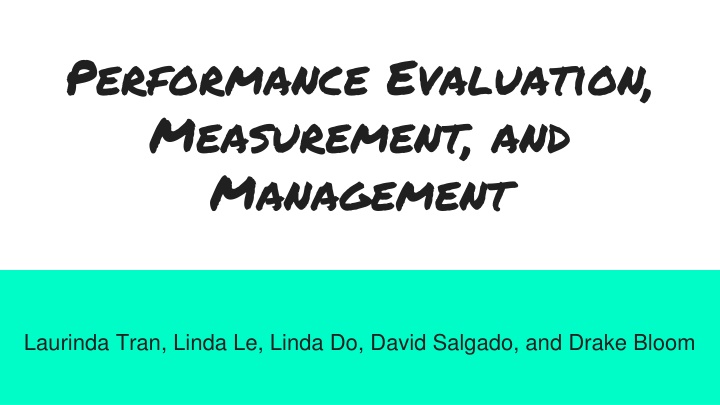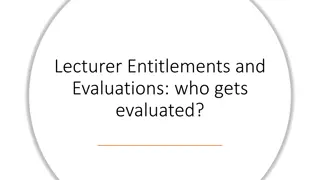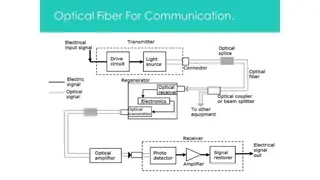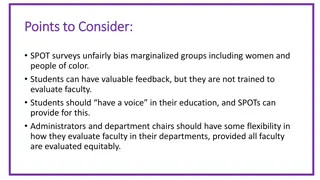Negative Effects of Competence Signals on Women's Performance Evaluations
This study explores how competence signals impact women's performance evaluations, revealing potential biases and implications for management practices. The research delves into social dominance orientation, performance measurements, and electronic monitoring in the workplace.
Download Presentation

Please find below an Image/Link to download the presentation.
The content on the website is provided AS IS for your information and personal use only. It may not be sold, licensed, or shared on other websites without obtaining consent from the author.If you encounter any issues during the download, it is possible that the publisher has removed the file from their server.
You are allowed to download the files provided on this website for personal or commercial use, subject to the condition that they are used lawfully. All files are the property of their respective owners.
The content on the website is provided AS IS for your information and personal use only. It may not be sold, licensed, or shared on other websites without obtaining consent from the author.
E N D
Presentation Transcript
Performance Evaluation, Measurement, and Management Laurinda Tran, Linda Le, Linda Do, David Salgado, and Drake Bloom
When Accomplishments Come Back to Haunt You: The Negative Effect of Competence Signals On Women s Performance Evaluations Presenter: Laurinda Tran
Key Terms Competence Signals Social Dominance Orientation (SDO)
Method Participants: 271 college-educated adults Design and procedure: Subordinate competence signal, subordinate gender, evaluator gender. SDO evaluator as continuous factor Participants act as managers
Measures Subordinate s performance rating -composed measure of performance evaluation SDO scale
Take-Home Message Objective measures (reduce bias) Stereotype programs Select low SDO & have screening Rewards & compensation Multiple hurdle PE
The Invisible Eye? Electronic Performance Monitoring and Employee Job Performance By Devasheesh P. Bhave Presenter: Linda Le
Key Terms Electronic Performance Monitoring (EPM) Counterproductive Work Behaviors (CWBs) Organizational Citizenship Behaviors (OCBs) Task Performance
Method Study conducted at 2 large call centers Used a web-based and paper-based survey Evaluated CSRs based on 3 performance dimensions
Measures Supervisory Use of EPM Call Complexity OCBs, CWBs, Task Performance Call Quality
Take-Home Message Make sure the EPM system is in compliance with privacy laws Offer Supervisors training programs EPM system also helps improve performance evaluation validity
Inherently Relational: Interactions Between Peers and Individuals Personalities Impact Reward Giving and Appraisal of Individual Performance Presenter: Linda Do
Key Terms Extraversion Agreeableness Dyadic
Method Study conducted for extra-credit in an upper management course Online questionnaire about team members, processes and participant s own personality
Measures Performance evaluations Agreeableness Extraversion
Take home message Formal Training Break Rooms Weighted Performance Evaluations
ARE TELECOMMUTERS REMOTELY GOOD CITIZENS? UNPACKING TELECOMMUTING S EFFECTS ON PERFORMANCE VIA I-DEALS AND JOB RESOURCES Presenter: David Salgado
Key Terms Telecommuting Intensity Contextual Performance Interpersonal Facilitation Job Dedication Leader-Member Exchange (LMX) High Low
Method Surveyed employees and supervisors from wide assortment of organizations that vary in the extent of telecommuting afforded to employees 323 employees 143 supervisors
Measures Telecommuting and Telecommuting Intensity Task Performance Contextual Performance LMX
Take home message Treat Telecommuting as a benefit that is mutually beneficial to the employee and company A form of work redesign that generates autonomy perceptions Form organizational policies pertaining to telecommuting Eligibility
Rocking the Boat but Keeping It Steady: The Role of Emotion Regulation in Employee Voice Presenter: Drake Bloom
Key Terms Voice Emotional Labor Strategies Surface Acting Deep Acting Kotter s 8 Steps Emotional Regulation Extraversion
Method Optometry company Customer-service-intensive Emotion regulation knowledge is relevant Sample: 100 employees Of the 209 total
Measures Emotional Labor Strategies Tested Surface and Deep acting Self Reported and scored on a 7-point scale Emotion Regulation Knowledge STEM - Situational Test of Emotion Management Graded against expert s scores
Measures continued Voice and Performance Evaluations Panel of three HR managers Evaluated on a 7-point scale Extraversion Five Factor Model 5-point scale
Take-Home Message Change the culture through a constructive confrontation approach Apply change management best practices such as Kotter s 8 steps Establish executive sponsorship Educate middle management on the desired behaviors and practices Reward and recognize the new behaviors
Group Take-Home Message Organizations need to reduce bias by having screenings on performance evaluation. Supervisors must give constant feedback and keep consistent documentation of employees Organizations need to institute a culture change which encourages constructive confrontation This will improve the relationship between middle and frontline employees Encourage employee voice























